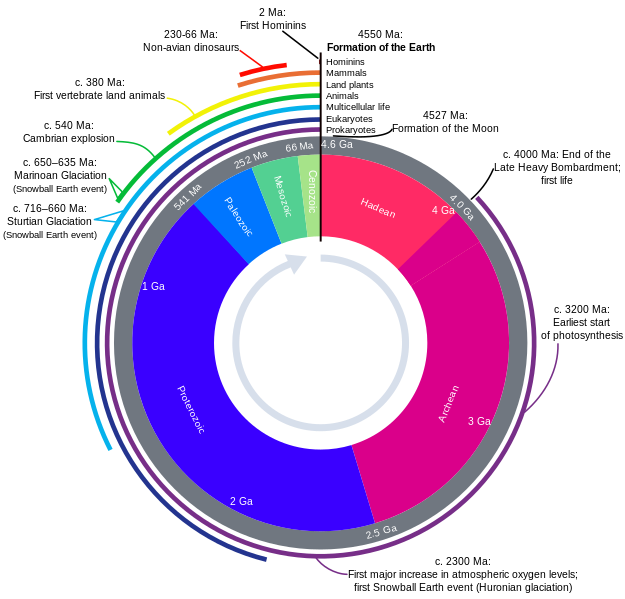Mesozoic Era - Weekly Blog (9/17-9/21)
 |
| File:Geologic Clock with events and periods.svg by Woudloper |
Summary:
The Mesozoic Era took place 245 to 66 million years ago. The Mesozoic era can be divided into three periods, known as Triassic, Jurassic, and Cretaceous. The first period is the Triassic period, which happened around 245-208 million years ago. During this period, the first dinosaurs, crocodiles, and turtles evolved. Cone-trees and other palm-like trees dominated the forests. The next period is the Jurassic period, taking place around 208-144 million years ago. During this period, large dinosaurs roam the world. Some of the first birds started appearing, and various mammals became more common. The last period during this era is the Cretaceous era, taking place 144-66 million years ago. During this era, the first flowering plants started appearing. At the end of this era, a mass extinction caused the disappearance of many organisms, mainly dinosaurs.
During the Mesozoic era, the world was connected to a supercontinent known as the Pangea. Around the middle of the Triassic period, the Pangea started to break apart, creating two smaller continents, known as Gondwana, and Laurasia. By the beginning of the Cretaceous period, the Pangea was spreading apart, and by the mid-Cretaceous, it had already split into many smaller continents.
According to the California Life Science Textbook, Mesozoic means "middle animals," and around the time when the world’s animals changed from that which had been seen in the Paleozoic. Some of the animals include lycophytes, glossopterids, dicynodonts, cycadeoids, and dinosaurs. As well as animals, the vegetation and plants during the Mesozoic era changed greatly. At the beginning of the Mesozoic era, major plants include ferns, cycads, ginkgophytes, bennettitaleans, and more. During the beginning of the Triassic periods, according to the University of California Museum of Paleontology, “Modern gymnosperms, such as conifers, first appeared in their current recognizable forms in the early Triassic. By the middle of the Cretaceous, the earliest angiosperms had appeared and began to diversify, largely taking over from the other plant groups.”
Comments
Post a Comment